Are we any closer to widespread claims automation across the insurance industry, or are the barriers insurmountable? Experts from the InsurTech and incumbent worlds weigh in with their opinions.
By Gareth Burden, Consultant, Sheffield Haworth Insurance & InsurTech practice
Interest in claims automation seems to be at an all-time high in today’s global P&C insurance industry. On the one hand, it’s easy to put this down to the rise of challenger digital insurers such as Lemonade, Hippo, or Hedvig, with their strong focus on rapid automated claims settlement.
Yet this undersells the fact that the industry has been seeking to reduce claims costs for years. Automation is just one way to achieve this, alongside other options such as retraining staff or reallocating resources to cope with fluctuations in demand, or refining processes to make them more efficient.
In the Sheffield Haworth Insurance & InsurTech practice, we’re always keen to understand how trends are impacting on the industry’s talent needs. So I spoke with Florian Graillot, founding partner of astoryaVC and a seasoned investor in European InsurTechs, to get his views on the topic.
I also spoke with two leading lights at Covéa Insurance – James Gearey, Managing Director, Personal Lines and Protection, and Stephen Long, Director of Operations – to get the opinion of an insurer that is an amalgamation of three brands, has made huge strides with its digital transformation, and won numerous awards for customer service in recent years.
What can established insurers learn from the upstart digital-first insurers? Or is it the startups that should be learning from the longstanding incumbents? Do consumers really want claims automation? At what point does automation go too far and the human touch become needed? And what does all of this mean for talent? What crucial skills gaps are there right now, and how can the industry look to plug these gaps in the next few years?
What’s driving interest in claims automation in the P&C insurance industry
As James Gearey puts it: “We’re here to support people when they need us to help them get out of whatever sticky situation they’re in. And I think since time immemorial there’s been the question of how can we mitigate those costs?”
From the InsurTech side, interest in claims automation technology has been pretty consistent, representing around 10% of all InsurTech investment each year since 2014, according to Florian Graillot.
“As to what has driven this, I think it’s coming from customers and from incumbents,” he says. “Customers want to have visibility of the process and better understand why they might be reimbursed less than the full value of a claim, why it takes so long to process a claim – or, on the other hand, why it’s quick – so here it’s really customer demand and the need to provide a good customer experience.”
Stephen Long agrees that customer expectations are a key driver of the current focus on claims automation. Customers now expect the same rapid, seamless experience from insurers as they do from all digital services, from Amazon to Deliveroo. “Heightened customer expectations have really driven this agenda,” he says.
Is claims automation more difficult for certain business lines compared with others?
Florian believes that some InsurTechs specialising in claims technology are finding some kinds of claims harder to process than others.
“When we look at visual intelligence InsurTechs such as Tractable or Bdeo there is a potential challenge there,” he says. “They began by applying their technology to car claims, which are easiest to standardise because car parts are standardised. But now these companies are trying to replicate their initial success in home claims, which is more challenging.”
For Covéa, different business lines don’t make as much of a difference as being able to judge each claim on a case-by-case basis according to what’s best for the customer.
“You really need to take it down to each service experience, each interaction point,” says Stephen, adding: “We use telematics data on a VitalityCar scheme that we underwrite. We’re learning about the g-force of an impact. We can see whether the car continues to move after the event which allows us to assess whether the customer might need assistance.
“There’s loads of data points and technology we can use to really understand whether that customer might need us or not, and to become more intuitive in our approach. You take it down to the individual customer: are they in need of a claim? Whether it’s their pet or something detected in their house, their car insurance, or a commercial product, that’s the level of understanding customers expect.”
As technology has improved elsewhere in the insurance value chain, claims must innovate to keep pace
The consensus from Florian and Covéa is that claims lags behind other parts of the value chain in terms of innovation. Augmenting or replacing a claims manager requires a high level of technological sophistication, Florian believes: “The level of technology needed to have reliable automated claims solutions is one reason why only 10% of InsurTech startups are in this space,” he says.
For Covéa , while claims lags digitally behind other service interactions, such as buying a policy, the industry recognises that this is an issue and is serious about solving it. “I think there’s absolutely recognition that claims needs to catch up with other parts of insurance to give customers the experience that they desire,” Stephen says.
Potential barriers to claims automation and innovation
For Florian, the two biggest potential barriers in this space are 1) access to data, and 2) building trust between InsurTechs and incumbents.
As he puts it: “An InsurTech needs access to historical insurance data to train their algorithm. So this is where you need a high level of trust and partnership between incumbents and startups, with the startup providing the algorithm and data science element, and the incumbent providing historical data.”
James and Stephen agree that data can be a barrier. As James says:
“I’m optimistic we’ve got the chance to capture more and more data, and we are a data industry. But we’re still struggling to see how to knit it all together. There are very few companies outside of InsurTechs that have pure golden source data, where all that data is the first point of arrival into the company and it sits in that one place. It’s usually filtered through numerous different systems and the various systems that pose a potential risk to the quality of that information.”
That said, for both Stephen and James the biggest question is not so much a barrier per se, but the need to know when to automate and when human intervention is still needed. Stephen describes an understanding of customer needs and customer readiness for innovation as “one of the biggest challenges – and advantages – that longstanding insurers have.”
James illustrates the point with the example of a car accident he’d had. When he tried to get through to his digital-only insurer, he found it difficult:
“When I needed to speak to someone, it was impossible, or it felt impossible. This kind of perception reflects on your impression of whether the company will look after you and serve you well. It made me very mindful of that very delicate equilibrium that you’re playing with when you get into this part of the value chain.”
As Stephen adds: “Whilst almost every insurance company and InsurTech wants to automate the claims service, it’s understanding where it’s most appropriate but also where the customers need the empathy of a real human being.”
Covéa has customer research going back ten years which shows that there is still high demand for human interaction at certain points in the insurance value chain, such as when providing a first notice of loss.
“You can have the best technology in the world but knowing where to blend in human interaction as well is absolutely pivotal,” Stephen says.
Florian agrees that knowing your customer is key to overcoming potential resistance to automated claims, while also emphasising that what most irate customers complain about is not receiving as large a payout as they expected:
“A person who is less digitally-literate is not going to want to self-serve using your website, however hard you try. This is also true of complex home insurance claims, where people will often want the reassurance of speaking to a live agent or claims adjuster. You can see this in the sheer volume of insurance marketing which emphasises that they have real people to deal with customers’ claims,” Florian says.
“However,” he adds, “busy executives will often value the convenience of using digital channels and getting a guaranteed response fast. If you provide a good claims service, on the whole people will care less about the channel being used and focus more on the service itself.”
So will customers every completely accept automation? It seems not. For Covéa and for Florian, the answer lies in understanding your customers and having enough data to be able to manage each case individually.
As Florian says: “I don’t think the industry will automate every claim. Not only will some customers always want human intervention, but many companies will be nervous of automating higher value claims. That means this is likely to be something we see for lower value, high-volume claims where any leakage is offset by the efficiency gains.”
Which InsurTechs or incumbents are making significant progress towards automating claims?
“I think everyone’s on the same journey,” says Stephen. “Every part of that supply chain is seeking to enhance and digitise their customer experience for all of the obvious benefits. The challenge is being able to stitch it all together.”
Covéa provides the claims fulfilment for several InsurTech businesses. As Stephen explains:
“InsurTechs generally have high levels of automation and self-service in their platforms, and Covéa augments that with experience on when to analyse the claim and be sure that it’s legitimate spend. It’s a really powerful blend when you can get the two entities working together, as we’ve found in many of our partnerships – particularly in the rapidly growing pet insurance sector.”
The lessons incumbents and InsurTechs can learn from each other
“There’s loads we can learn from the usurpers, from the challengers, from the new companies, because they’re not looking at it with that 300-year-old lens,” James says, adding that it’s always healthy to have newcomers enter an industry to ask why things are done the way they are, and whether or not they could be improved.
“I’ve always found it interesting when you see people who are fresh to an industry, they’ll ask why things are done the way they are. The kinds of questions that over time you forget to ask yourself once you start to accept how things work already,” James says.
He adds that many digital disruptors in insurance have already demonstrated that they can win the trust of consumer, ManyPets being one example. “Trust for traditional insurance still needs some work,” James says, “and yet these new insurers have none-the-less engendered a high degree of trust very quickly.”
James feels that some of that trust has come about as a result of faster, smoother digital processes and finding new ways to engage customers. “But the insurance industry is 300 years old for lots of good reasons too,” he adds. “Insurance has learned a hell of a lot in that time, and we have an incredible wealth of insight and breadth of knowledge.”
So, when it comes to understanding customers, there’s much that incumbents could teach Insurtechs too.
“As incumbents, we’re still obsessed with providing great customer service,” Stephen adds. “It’s not like InsurTechs are the only ones who care about customer, but what we have is all that experience of the discipline you need to operate successfully. You’ve got to control your indemnity spend. You’ve got to have initiatives to control cost as well as delighting the customer.
“In our business I often have really quite challenging conversations with our customer experience team because naturally they’re advocating quick, empathetic, and straightforward claims and putting the customer back in the place they were before the event happened as quickly as we can. We clearly want to do that for as many as we can. But we also need to follow our philosophy of ensuring every claim is a genuine warranted one. Sadly, sometimes they are not.”
For Stephen, discipline is key – the discipline to know when human intervention is needed, both to improve the customer experience, and to combat potential fraudulent claims when necessary.
Which technologies are needed to make claims automation a reality?
It’s clear that artificial intelligence (AI) is driving a lot of claims automation initiatives and dominating much of the conversation on the topic. Covéa is currently looking at how best to leverage AI investment to help speed up claims processing by developing an algorithm that will flag up certain characteristics where a claim can be put straight through or highlighted for further investigation.
Florian mentions optical character recognition (OCR), which automates data extraction from printed documents, as a significant offshoot of AI, as well as visual intelligence and algorithms. However, as he points out, the key that underpins all of this is “the need to optimise data collection and analysis.”
James and Stephen agree. As Stephen says:
“The data helps you be intuitive about your customer experience to help improve that experience delivery, but data also allows you to really understand customer behaviours. If I can link buying behaviour at point of quote to triggers at point of claim that say something’s not quite right here, if I can join those two pieces of data together, that might then drive a different claims outcome.”
What kind of talent or skills does the market need to make claims automation a reality?
Due to the importance of data collection, storage, and analysis, it’s perhaps unsurprising that “digital and data-savviness are going to being imperative,” according to Stephen.
Florian agrees and sees this as a key opportunity for InsurTechs: “Building a strong algorithm relies on building a great data science team, and this is where startups can excel, because my impression is that incumbents struggle with this. Hence, as an investor, the opportunity when investing in InsurTech startups is really the opportunity to leverage that data expertise that incumbents struggle to develop inhouse.”
Stephen confirms that this impression is accurate: “This is an area where it’s hard to recruit as there aren’t huge numbers of people coming into this space. All those things we’re talking about are depending on data and technology underpinning those services, so there’s absolutely a need for more people in that area.”
Several of Covéa’s leadership team are on the governing bodies of their local schools and colleges because they recognise that the UK’s future will depend on teaching and training more young people to be computer and data literate.
James makes the point that senior leaders of insurance incumbents do need to become more knowledgeable about certain aspects of digital technologies, and be able to communicate with more technical talent, as well as being able to translate the needs of technical departments back to the rest of the business.
For senior leaders within incumbents, accounting, financial, and digital skills will remain prevalent. But they will also need to be great cross-functional communicators with the ability to empathise and understand the often very disparate motivations of different groups within the business.
This emphasis on empathy and communication is one with which Florian thinks is also important from an InsurTech perspective, saying: “The ability to build and maintain relationships with incumbents is important after that, as is the ability to sell the value of your tech stack.
“The startups need to understand which of an incumbent’s challenges their technology will solve, and have a solution that works, as well as the ability to influence the incumbent to work with them.”
Claims automation – top takeaways
- Claims automation is being driven by three main things:
- Desire to offer a frictionless k customer experience
- Desire to save claims expenses by making processes more efficient
- The ability of AI to help automate processes
- There will always be a limit to how much of the claims process can be automated, because:
- Some customers will always prefer or need human interaction
- At certain touchpoints, human interaction will provide better customer experience
- Too much automation could increase potential claims fraud, or leakage.
- Data scientists and data analysts will be essential in the future if claims automation is to become more common.
- However, claims will also still need client-facing talent, as well as those with responsibility for managing books of business and controlling costs. InsurTechs still need industry expertise when it comes to claims, while incumbents need to maintain their underwriting expertise.
- Due to the widespread focus on digital transformation across financial services, data scientists and data analysts are increasingly hard to find – as are data engineers and risk modellers.
- To try to overcome the difficulty of hiring digital talent, insurers and InsurTechs have started to market the potential benefits of working on their specific products rather than the insurance sector itself.
- Senior leaders in incumbent insurers will need to display empathy, a certain degree of digital literacy, and the ability to communicate effectively across functions to their existing skills.
- InsurTechs need to be able to understand exactly what challenges their tech stack can solve for incumbents and be able to communicate this effectively to help them build relationships with incumbents. This clarity can also help them to attract top talent.
- While incumbents can learn from InsurTechs’ tendency to challenge existing ways of doing business, InsurTechs can also learn from incumbents’ knowledge of customers, their decades of data, and their focus on the discipline of underwriting and cost control.


















